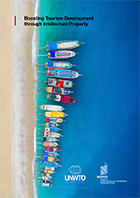New Report Shows Value of IP to the Tourism Sector
May 6, 2021
A new report published jointly by WIPO and the World Tourism Organization (UNWTO) on the value of intellectual property in boosting tourism shows how the IP system creates a favorable ecosystem for innovation, entrepreneurship and investment in the sector.
The publication, entitled “Boosting Tourism Development through Intellectual Property,” highlights good practices, features case studies and recommendations for policymakers and other tourism stakeholders on how to ensure that creativity, innovation, traditions and cultural heritage in tourism are properly protected and commercialized and that the benefits are shared by all.
In a joint Foreword, WIPO Director General Daren Tang and UNWTO Secretary General Zurab Pololikashvili, predict that while the tourism sector has taken a hit during the COVID-19 pandemic, it will recover and “contribute to reigniting hard-hit economies and societies thanks to its capacity to adapt to changes and offer innovative solutions to new challenges.”
“In this context, IP rights are powerful tools that can be used to boost tourism development and competitiveness. The IP system is designed to promote creativity and innovation and support efforts by individuals, businesses and other actors to differentiate themselves and their products and services in the marketplace, whether through trademarks, geographical indications, copyrights or patents,” they added.
The publication provides practical guidance for non-IP specialists on how to include IP in tourism product development – from destination branding to tourism policies. It shows how different IP rights can be leveraged to raise funds. It showcases successful experiences and demonstrates how stakeholders around the globe are using IP rights to add value to tourism services and products, as well as to protect and promote local knowledge, traditions and cultural heritage.
Through examples of producing cheese, tea, pepper, wine or other products, the publication shows how geographical indications and appellations of origin can be used to support the growth of rural tourism and provide benefits to local communities.
To leverage the full potential of the IP system, the report recommends inclusion of IP strategies in national tourism plans and tourism policy strategy for regional and local destinations. Not only does good IP knowledge and management help to make use of the protected intangibles, but it also attracts investments and leverages fundraising opportunities.
Finally, tourism authorities are encouraged to raise awareness among tourism and destinations stakeholders on the importance of appropriate IP knowledge and management to foster the sector’s growth in these challenging times.
